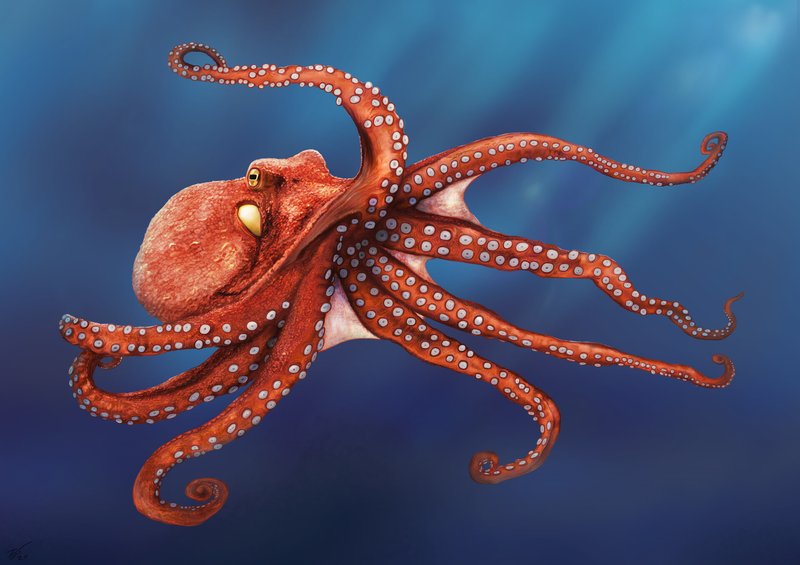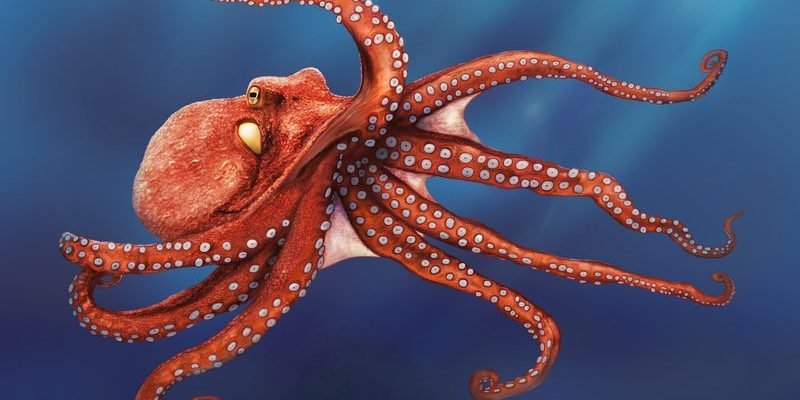
These fascinating cephalopods are the largest of their kind, renowned for their impressive size—some can weigh over 100 pounds! But it’s not just their physicality that’s captivating; it’s how they move and interact in their ocean homes. So, grab your coffee, and let’s dive into the world of the Giant Pacific Octopus to understand how they navigate their environment and communicate effectively.
Understanding the Giant Pacific Octopus
The Giant Pacific Octopus (Enteroctopus dofleini) is native to the North Pacific Ocean, often found in coastal waters ranging from California to Alaska. They can grow up to 16 feet long, but what truly sets them apart is their remarkable adaptability. These octopuses live in dens, often made from rocks or shells, which serves as their home base.
What’s truly intriguing is their flexible body. Unlike fish that have rigid structures, the octopus can squeeze through tight spaces thanks to its lack of a bony skeleton. This means they can navigate through small crevices, hiding from predators and stalking prey at the same time. It’s like playing hide-and-seek, where they’re both the hider and the seeker.
But beyond their movements, they’re highly intelligent creatures with problem-solving skills that rival many mammals. They might even be capable of recognizing individual humans! This intelligence plays a crucial role in how they interact with both their environment and other marine life.
The Art of Navigation
Navigating through the ocean is no small feat. The Giant Pacific Octopus employs a combination of keen eyesight and memory to move through its habitat. They have excellent vision, capable of seeing in low light and detecting colors, which aids in spotting prey or predators.
Their navigation isn’t just visual, though. Octopuses also use their sense of touch. With hundreds of sensitive suckers lining their eight arms, they can feel their environment in ways that humans can’t even imagine. Picture this: while you may use your hands to feel different textures, the octopus uses its suckers to explore and gather information about its surroundings.
Moreover, these octopuses often utilize their incredible camouflage abilities. By changing their skin color and texture, they can blend seamlessly with rocks or coral, which not only helps them hide but also plays a role in how they navigate—making it easier to sneak up on prey or evade danger.
Camouflage: A Unique Communication Tool
Speaking of camouflage, one of the most fascinating aspects of the Giant Pacific Octopus is how it can communicate through its skin. It’s not just for blending in; they can change colors to convey different messages.
Octopuses have specialized skin cells called chromatophores that expand and contract to show color changes. For example, when they feel threatened, they might turn dark to signal aggression or to blend in with rocky substrates. Conversely, during courtship, they may display brighter colors to attract a mate.
This ability to communicate is vital. It’s like having a visual language that others can understand. And since octopuses are generally solitary creatures, this form of non-verbal communication helps them avoid conflicts while also finding mates. It’s a delicate dance in the ocean’s depths, showcasing a level of complexity you might not expect from a creature that spends most of its life alone.
Using Body Language to Communicate
Beyond color changes, the Giant Pacific Octopus also engages in body language. When they want to communicate or intimidate, they can spread their arms wide or make themselves appear larger. You can think of it like a cat puffing up to appear more threatening.
Additionally, they may mimic the posture or movements of other marine creatures, a form of mimicry that can confuse or deter potential threats. This behavior shows not just intelligence but adaptability, as they adjust their body language based on the situation.
In social situations, even if they’re rare, you might witness some interesting interactions. During mating, males will approach females cautiously, using their limbs to signal their intentions. It’s a moment that requires delicate balance and understanding—after all, the ocean can be a dangerous place for a suitor!
Learning and Problem-Solving Skills
One of the most astonishing traits of the Giant Pacific Octopus is its ability to learn. Research has shown that they can solve complex problems and learn from experiences. For instance, if placed in a maze, they can find their way out while remembering the layout for future reference.
Their intelligence also shines through in the way they manipulate objects. In captivity, they’ve been observed unscrewing jar lids to reach food, demonstrating fine motor skills and an understanding of cause and effect. This not only showcases their cognitive abilities but also highlights how they can adapt to different scenarios, whether in the wild or in a controlled environment.
This problem-solving capability is essential for survival, especially when hunting or escaping predators. It’s a powerful reminder that intelligence exists in many forms, and these octopuses are a testament to that notion.
The Impact of Environment on Behavior
The environment in which the Giant Pacific Octopus lives significantly influences its behavior. With varying water temperatures, depths, and the presence of other marine life, these factors shape not only how they navigate but also how they communicate.
In warmer waters, for instance, their activity levels can increase, leading to more interactions with potential mates or rivals. Similarly, in areas densely populated with prey, their hunting techniques might become more aggressive or refined to adapt to the abundance of food.
Moreover, environmental changes, such as rising sea temperatures or pollution, can affect their communication and navigation abilities. Researchers are continuously examining how these changes impact octopus populations, aiming to understand the larger picture of ocean health and biodiversity.
The Giant Pacific Octopus is a true marvel of the ocean, showcasing a combination of stunning navigation techniques and unique communication methods. Through their impressive camouflage, body language, and problem-solving skills, they exemplify intelligence that is both fascinating and complex.
Understanding how these creatures move and interact not only deepens our appreciation for them but also highlights the importance of preserving their natural habitats. The ocean is vast and filled with wonders, and the Giant Pacific Octopus is just one of many incredible stories waiting to be explored. So next time you think about life beneath the waves, remember the adaptability and intelligence of these amazing beings, and let that curiosity guide your adventures into the deep blue sea.

